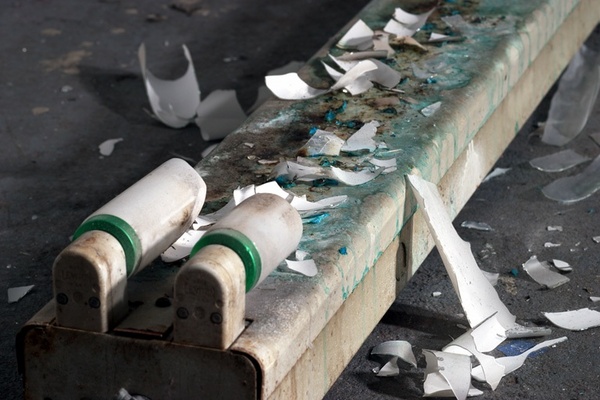This is an archive of the ArtCat Zine, 2007-2009. Please visit our new project, IDIOM.
Light on Light at Cleopatra's
Last Thursday artist Andres Laracuente presented Light on Light, a sculptural work activated by a performance, at Cleopatra’s, a new exhibition venue in Greenpoint, Brooklyn. The work was materially composed of two long and fluorescent tube lights facing up and installed in a standard metal base some inches above the gallery floor. When the gallery filled with invited guests, a blue liquid was poured carefully up and down the length of two bulbs and subsequently set afire, producing a near invisible flame. The harsh cold light from the flourescents was the only illumination in the gallery space, and it remained on briefly, sharply contrasting with the more chemical glow of the exposed flame. Moments later both bulbs extinguished and burst loudly, shattering glass across the gallery and filling the space with a soft, troubling odor.
The work recalls Anthony McCall’s 1970s Landscape for Fire series, in which the artist laid out meticulous grids of flammable materials in empty fields, later performing with his assistants and lighting the grids on fire as night fell. The going of one kind of light and the coming of another for McCall was here the violent snuffing of the fluorescent lights for Laracuente: a transitional state that makes that which is otherwise barely perceptible visually dominate. This moment – the flicker of the lights before their termination, the silence before the explosion of the bulbs – is the center of Laracuente’s piece, embedded by the artist in his otherwise minimal office aesthetic; rather than occupying a large outdoor space like McCall, Laracuente works modestly and usually presents the piece in his studio or a gallery. Instead of the sun whose absence makes possible McCall’s work, in Laracuente’s case it is the play of the white fluorescent lighting that produces the visual impact that is eventually transformed into another kind of phenomenon. Not the least of that impact was surely fortified by the evocations of abundance and scarcity (of light, energy, and order). These two are tokens in an environmentalist rhetoric that is everyday winning new ground in our popular culture, moving, since its somewhat rarefied 18th century origins in this country, to become popular political and lifestyle talking points, as well as coordinates on a rapidly developing entrepreneurial field.
Following the performance, the trace material of Light on Light, two shattered fluorescent bulbs, remained on view through Cleopatra’s storefront display until yesterday, when the work was deinstalled.
ZINE
HOME
TIPS / COMMENTS
CATEGORIES
CONTRIBUTORS
- Greg Afinogenov
- B. Blagojevic
- Adda Birnir
- Susannah Edelbaum
- Julie Fishkin
- Paddy Johnson
- Jessica Loudis
- Christopher Reiger
- Andrew Robinson
- Peter J. Russo
- Blythe Sheldon
- S.C.Squibb
- Hrag Vartanian

